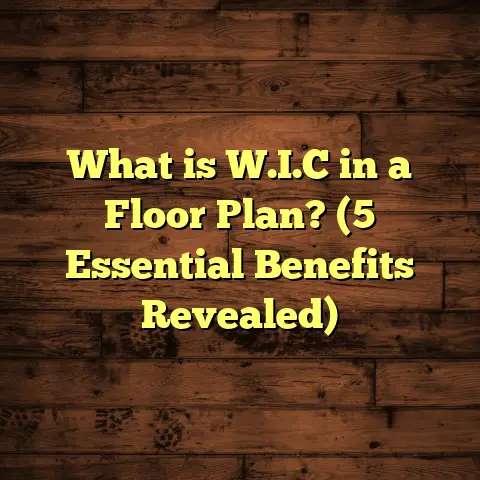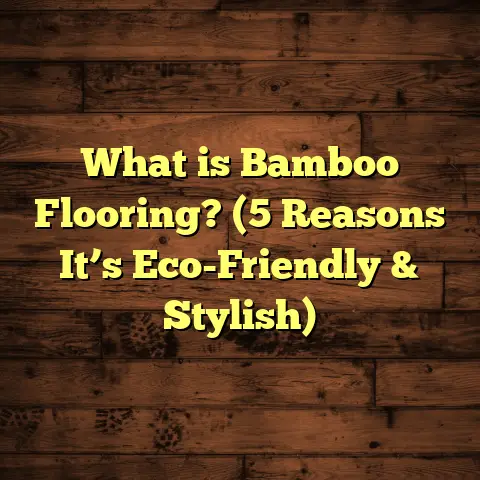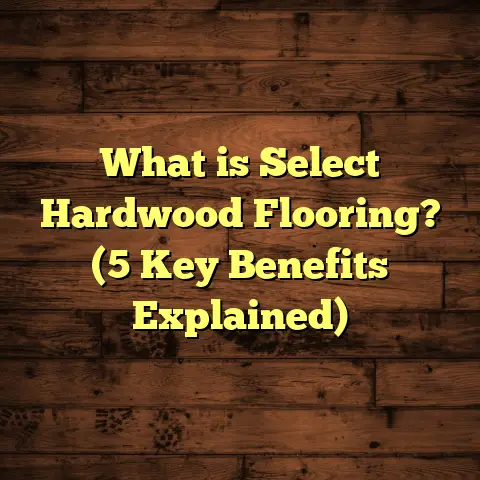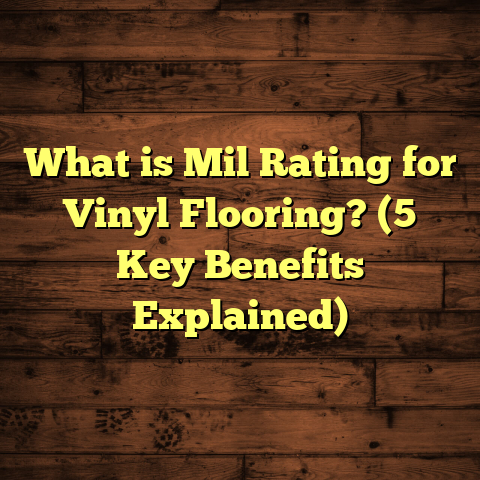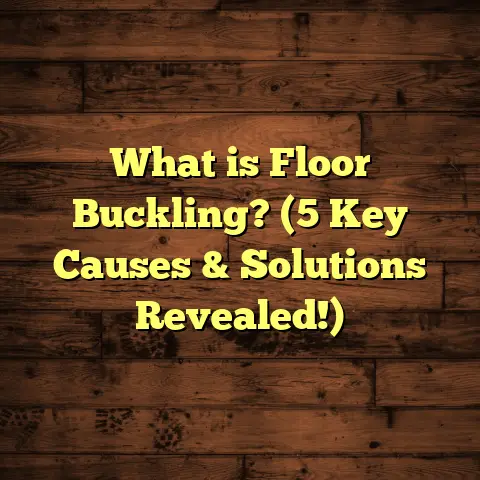What is Cheaper: Carpet or Flooring? (5 Key Cost Factors Revealed)
I still recall vividly the moment I had to decide between carpet and hard flooring for my own home.
It was a chilly autumn evening. I stood in my nearly empty living room,
running my hands over carpet samples and wooden planks laid out on the floor.
My mind raced with questions: “What fits my budget? What will stand up to my kids’ energy?
What will keep the house cozy in winter? And how much will I really spend?”
If you’re wrestling with the same questions, you’re in good company.
Over the years, I’ve helped countless homeowners navigate this very crossroads.
I’ve seen budgets blow up when hidden costs appeared, or when a seemingly cheap material didn’t last.
I’ve watched people regret their choices and others rejoice in their smart decisions.
Today, I want to share with you everything I’ve learned about what really costs less—carpet or hard flooring—so you can feel confident making your own choice.
What is Cheaper: Carpet or Flooring?
First, let’s clarify what we’re talking about here. When most people say “flooring,” they usually mean hard surface flooring such as:
- Hardwood
- Engineered wood
- Laminate
- Vinyl (including luxury vinyl tile/plank)
- Ceramic or porcelain tile
Carpet falls into a different category: it’s a textile floor covering made of woven or tufted fibers attached to a backing material.
So, when we ask “What is cheaper: carpet or flooring?”, we’re really comparing two broad categories: soft floor coverings versus hard floor coverings.
The answer isn’t straightforward because cost depends on many factors beyond just the price tag on the box.
Here are the main cost factors that determine which option will be more affordable for you:
- Material Price
- Installation Costs
- Maintenance and Upkeep Expenses
- Lifespan and Replacement Frequency
- Hidden or Unexpected Costs
I’ll walk through all of these one by one, sharing numbers from my personal projects and some industry data, so you can get a full picture.
1. Material Cost: What’s On The Price Tag?
When it comes to raw material cost, carpet often starts off cheaper than many hard surface floors. But there’s a wide range in quality—and price—within each category.
Carpet Pricing
Basic polyester or olefin carpets can start as low as $1 per square foot.
Mid-range nylon carpets, which are more durable and stain-resistant, usually run between $2 and $5 per square foot.
High-end wool carpets or designer nylon carpets can go upwards of $8 or $10 per square foot.
I once worked on a project where the client chose a low-end polyester carpet for a basement rec room. The cost was just around $1.20/sq ft, which fit their tight budget perfectly.
But I’ve also installed wool carpets in upscale homes costing over $12 per sq ft—and these felt luxurious but came with a hefty price tag.
Hard Flooring Pricing
Hard surface floors cover a wide price range too:
- Laminate Flooring: Usually $1.50 to $4 per square foot. A popular budget-friendly option that mimics wood look but is less durable than real hardwood.
- Vinyl Flooring: Vinyl sheet or luxury vinyl plank (LVP) costs about $2 to $5 per square foot depending on quality and design. Vinyl is water-resistant, making it great for kitchens and bathrooms.
- Engineered Hardwood: Typically $4 to $7 per square foot. It looks like hardwood but has a plywood base for stability.
- Solid Hardwood Flooring: Can start at $5 and go as high as $15 per square foot for exotic species like Brazilian cherry or walnut.
How Do These Prices Translate?
Here’s a rough comparison for mid-range materials over 1,000 square feet:
| Flooring Type | Material Cost (Mid-Range) | Total Cost for 1000 sq ft |
|---|---|---|
| Carpet (Nylon) | $3/sq ft | $3,000 |
| Laminate | $3/sq ft | $3,000 |
| Vinyl (LVP) | $3.50/sq ft | $3,500 |
| Engineered Wood | $5/sq ft | $5,000 |
| Solid Hardwood | $7/sq ft | $7,000 |
Personal Insight:
In my experience, many homeowners assume hardwood is always out of their price range before even checking prices—yet sometimes mid-range engineered wood or better vinyl options fit their budget better than they imagined.
2. Installation Costs: Labor Is Not Free
Even if your material costs are low, installation labor can add significantly to your total bill—and it varies widely by flooring type.
Carpet Installation Costs
Carpet installation generally involves:
- Laying down padding (underlay) for comfort and insulation
- Stretching and fitting the carpet tightly over tack strips
- Trimming edges neatly
Labor costs average between $1 and $3 per square foot, depending on your region and the complexity of the job.
One time, I installed carpet in an oddly shaped room with lots of corners and stairs; the labor cost was closer to $3 because of the extra cutting and fitting involved.
Hard Flooring Installation Costs
The complexity jumps up for hard floors:
- Laminate installation is often a floating floor system—planks click together without glue or nails—making it faster and cheaper to install (about $2-$5 per sq ft).
- Engineered hardwood usually requires glue or nails; labor ranges from $4-$8 per sq ft.
- Solid hardwood installation can be tricky—nailing down boards properly is labor-intensive and costs $6-$10 or more per sq ft.
- Tile floors are the priciest to install because they require mortar, precise cutting, grout application, and sealing—labor alone can hit $8-$15 per sq ft.
Real Talk:
I’ve seen homeowners shocked when their “cheap” flooring becomes expensive after installation fees pile up. For instance, installing oak hardwood in a 500 sq ft room might cost you close to $10,000 total once labor is included—even if your material was only $3,000.
3. Maintenance Costs: What Will You Spend Over Time?
Maintenance is the silent budget killer many forget until problems arise.
Carpet Maintenance
Carpet needs regular vacuuming and periodic deep cleaning (steam cleaning). Professional cleaning every 12-18 months usually costs between $100-$300 per session depending on size.
With pets or kids, stains and odors can mean more frequent cleaning or even spot treatments with special products.
Over 10 years, maintenance on carpet can add up to several hundred dollars or more.
Hard Flooring Maintenance
Hard floors generally require less intensive maintenance:
- Laminate and vinyl: Just sweep regularly and mop occasionally with recommended cleaners. Minimal costs here—maybe $20-$50 over 10 years for supplies.
- Hardwood floors: Need refinishing every 7-10 years to restore appearance; refinishing costs run about $3-$5 per square foot but can extend life significantly.
- Tile floors: Require grout cleaning and occasional sealing; minor costs compared to carpet upkeep.
My Experience:
I once installed carpet in a rental property where tenants neglected basic cleaning—it wore out fast and had to be replaced after just five years. The landlord regretted not paying a bit more upfront for hard floors that would stand up better to wear.
4. Lifespan: How Long Will Your Floor Last?
Knowing how long your floor lasts helps you calculate true cost over time.
Carpet Lifespan
Carpet typically lasts 5-15 years, depending on quality and usage. Low-end carpets might only survive 5 years before looking worn or stained beyond repair.
In busy family rooms or hallways, expect lifespan toward the lower end of that range.
Hard Flooring Lifespan
Hard floors last longer:
- Laminate: 10-20 years if kept dry and cared for properly. Water damage shortens its life drastically though.
- Engineered Hardwood: 20+ years with occasional refinishing possible depending on veneer thickness.
- Solid Hardwood: Can last decades—30+ years is common; some floors last generations if maintained.
In one client’s historic home I worked on, original oak floors were still in great shape after 60 years!
5. Hidden Costs: Watch Out For These Budget Traps
You might think your costs are set once you pick material and install labor—but there’s more beneath the surface:
Removal Fees
Removing old flooring can cost $1-$4 per square foot depending on material type and disposal rules.
For example, removing glued-down vinyl tile is tougher and pricier than peeling up old carpet.
Subfloor Repairs
Uneven or water-damaged subfloors must be repaired before new flooring goes down—this can add hundreds or thousands of dollars depending on damage extent.
I once had to halt an installation because the subfloor was severely warped; repairs added nearly 20% to the project cost.
Waste Factor
Flooring installers typically recommend ordering 5%-10% extra material for cuts, mistakes, pattern matching (especially with tile or hardwood).
Failing to account for this means surprise purchases later at possibly higher prices.
Furniture Moving Fees
Some installers charge extra if they need to move heavy furniture out of rooms before starting work.
How FloorTally Helped Me Sharpen My Estimates
Before I started using tools like FloorTally, I juggled multiple spreadsheets trying to piece together local labor rates, material prices, waste factors, and installation complexities—all from different sources.
FloorTally consolidates all this into one place:
- You plug in your room size and choose flooring types/materials matched to your region’s labor costs.
- It factors in waste percentage based on your inputs (room shape/complexity).
- You get instant side-by-side cost comparisons that include materials plus installation plus hidden costs like removal or subfloor prep.
When I was pricing a 400 sq ft kitchen renovation recently, FloorTally showed me that vinyl plank flooring would cost around 20% less than engineered hardwood once all costs were tallied—not just materials alone.
It changed how I advise clients by giving realistic budgets upfront instead of optimistic guesses.
Deep Dive Case Study: Carpet vs Laminate in a Family Playroom
Let me share one detailed example from my recent work with a family deciding between carpet and laminate flooring in their kids’ playroom:
Room size: 350 sq ft
Traffic: High (active kids)
Budget: Moderate ($2,500 – $4,000)
Step 1: Material Cost
| Flooring Type | Unit Price ($/sq ft) | Total Material Cost |
|---|---|---|
| Nylon Carpet | 3 | 1,050 |
| Laminate | 3 | 1,050 |
Materials were roughly equal since they chose mid-range nylon carpet vs mid-grade laminate planks.
Step 2: Installation Cost
| Flooring Type | Labor Price ($/sq ft) | Total Labor Cost |
|---|---|---|
| Carpet | 2 | 700 |
| Laminate | 3 | 1,050 |
Laminate installation was higher due to plank locking systems requiring precise fitting.
Step 3: Maintenance Over 10 Years
| Flooring Type | Estimated Cleaning Cost | Additional Maintenance | Total Maintenance Cost |
|---|---|---|---|
| Carpet | 1,500 (cleanings every year) | Spot treatments | 1,500 |
| Laminate | Minimal | Occasional mop | 150 |
Carpet cleaning was estimated at around $150 annually; laminate just needed sweeping/mopping supplies.
Step 4: Lifespan & Replacement
Carpet expected lifespan: ~7 years (replacement needed within decade)
Laminate expected lifespan: ~15 years (no replacement likely needed)
Replacement cost factored into carpet total budget since it would need full replacement once during decade.
Final Cost Over 10 Years:
| Flooring Type | Total Material + Labor | Maintenance + Replacement | Grand Total |
|---|---|---|---|
| Carpet | 1,750 | 3,000 | 4,750 |
| Laminate | 2,100 | 150 | 2,250 |
What Did They Choose?
Despite higher upfront installation costs for laminate, the family chose laminate because:
- Easier cleanup from spills/messes
- Longer lifespan without replacement hassle
- Healthier environment (less dust/allergens trapped)
This real-world example highlights how initial purchase price alone can be misleading.
Comfort vs Cost: What About How It Feels Underfoot?
Money aside—have you thought about comfort? Carpet feels soft and warm which is great for bedrooms or cold climates.
Hard floors can feel cold but offer cleaner surfaces especially helpful for allergy sufferers or homes with pets.
A personal touch: I always suggest area rugs on hard floors if warmth is desired—this way you get durability AND comfort without sacrificing style or budget too much.
Environmental Considerations That Impact Cost Too
One aspect often overlooked is environmental impact—and some consumers prioritize sustainability alongside price.
Carpet manufacturing uses synthetic fibers which may not biodegrade well; disposal can be problematic. However, recycled fiber carpets exist but tend to cost more upfront.
Hardwood flooring sourced responsibly can last generations—reducing waste over time—but exotic woods might contribute to deforestation if not certified.
Vinyl flooring raises concerns about VOC emissions though newer low-VOC products help mitigate this.
Environmental impact won’t directly affect your wallet immediately but should factor into long-term value calculations for many buyers today.
How Financing Options Can Affect Your Choice
Sometimes it’s not just what costs less overall but what fits your cash flow right now.
Many flooring stores offer financing plans that let you spread payments over months/years—this can make pricier hardwood options accessible even if upfront cost seems high.
However, interest rates must be considered as they increase total paid over time.
Summary of Cost Factors at a Glance
Here is a quick recap of what affects your total spend when choosing between carpet and hard flooring:
| Factor | Carpet | Hard Flooring |
|---|---|---|
| Material Cost | Usually lower upfront | Usually higher upfront |
| Installation Cost | Moderate ($1-$3/sq ft) | Varies widely ($2-$15) |
| Maintenance Cost | Higher over time | Lower over time |
| Lifespan | Shorter (5-15 years) | Longer (10-30+ years) |
| Hidden Costs | Removal & cleaning fees | Subfloor prep & removal |
Questions To Ask Yourself Before Choosing
If you’re still unsure which path makes sense for your home or budget, consider these questions:
- How long do I plan to stay in this home? Short stays might favor cheaper initial options like carpet. Longer-term owners may want durable hard floors.
- Do I have pets or kids that make spills/stains likely? Hard floors are easier to clean.
- What’s my tolerance for maintenance? Carpet needs more upkeep.
- Am I sensitive to allergens? Hard floors tend to be better.
- What style fits my home aesthetic? Sometimes style preference drives decision more than cost.
- Do I have budget flexibility now versus long term? Financing options may influence choice.
- How important is resale value? Homes with hardwood often sell better.
Answering these will help you understand your priorities beyond just price tags.
Wrapping Up My Take
I hope sharing my hands-on experience combined with data-backed insights helps clear up confusion around “what is cheaper: carpet or flooring?”
From where I stand after installing thousands of square feet of both types:
- Carpet tends to be cheaper upfront but costs more over time due to maintenance/replacement needs.
- Hard flooring costs more upfront but lasts longer with lower upkeep.
- Hidden costs and labor fees can swing total investment significantly.
- Using tools like FloorTally has transformed how I estimate budgets—making them realistic from day one.
- Comfort and style preferences remain important alongside financial considerations.
- Real family scenarios prove cost-effectiveness depends on your unique situation—not one-size-fits-all answers exist here.
If you want me to crunch numbers for your exact project dimensions/materials/local rates using tools I trust—just ask! I’m happy to provide personalized guidance so your floor choice feels right both in your heart and your wallet.
